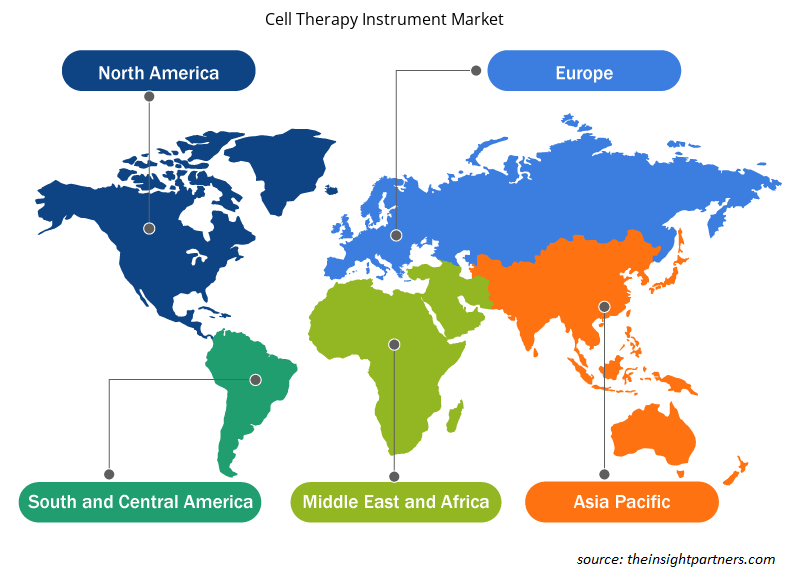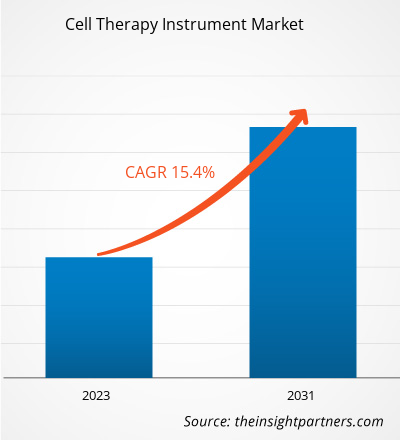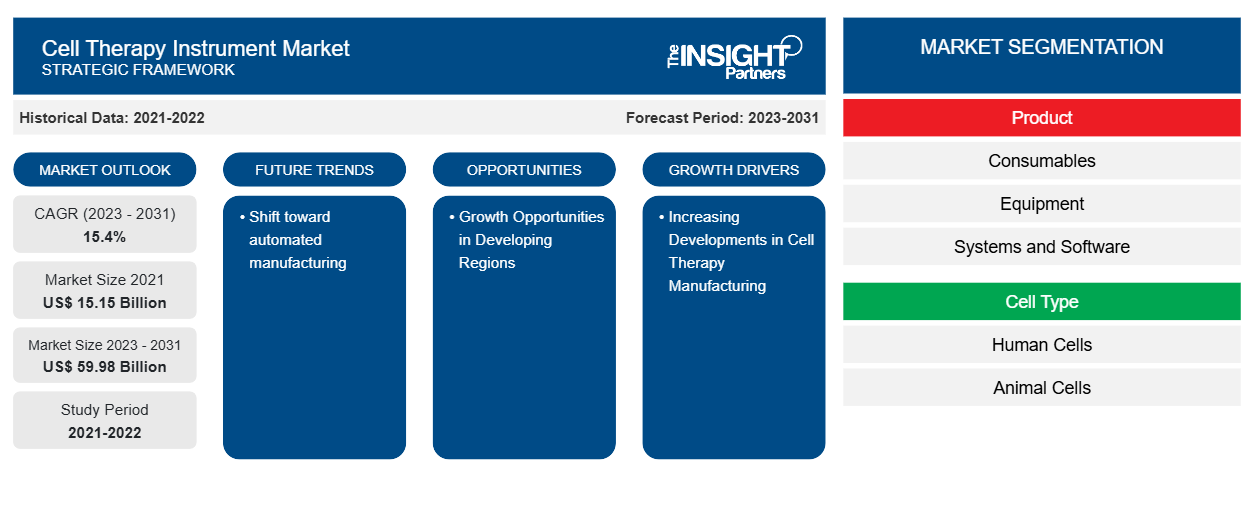Il mercato degli strumenti per la terapia cellulare è stato valutato a 15,15 miliardi di dollari nel 2021 e si prevede che raggiungerà i 59,98 miliardi di dollari entro il 2031. Si prevede che il mercato registrerà un CAGR del 15,4% nel 2023-2031. Il passaggio alla produzione automatizzata rimarrà probabilmente una tendenza chiave del mercato degli strumenti per la terapia cellulare.
Analisi di mercato degli strumenti per la terapia cellulare
La terapia cellulare è quando cellule vive e intatte vengono iniettate, impiantate o innestate nel corpo del paziente. Ad esempio, a una persona con cancro vengono iniettate le cellule T durante il ciclo di immunoterapia. La somministrazione di strumenti per la terapia cellulare varia dalle iniezioni all'impianto chirurgico mediante dispositivi speciali. La terapia cellulare ha applicazioni in un gran numero di disturbi. Le malattie più importanti del sistema nervoso sono il cancro. Altre applicazioni includono condizioni cardiache (infarto miocardico e insufficienza cardiaca), diabete mellito, ossa e articolazioni, disturbi genetici e ferite della pelle e dei tessuti molli.
Panoramica del mercato degli strumenti per la terapia cellulare
Uno dei metodi più promettenti per il trattamento del cancro è la terapia con cellule T con recettori antigenici chimerici (CAR), e ogni anno vengono condotti un numero enorme di studi preclinici e clinici per aumentarne l'applicazione. Dopo decenni di ricerca, la terapia con cellule CAR-T si espanderà inevitabilmente. Oltre ai prodotti autologhi e allogenici , nel futuro delle terapie cellulari saranno studiate anche nuove terapie geniche con cellule CAR-T in vivo e l'efficacia in indicazioni diverse dalle neoplasie ematologiche.
Personalizza questo report in base alle tue esigenze
Riceverai la personalizzazione gratuita di qualsiasi report, comprese parti di questo report, o analisi a livello nazionale, pacchetto dati Excel, oltre a usufruire di grandi offerte e sconti per start-up e università
-
Scopri le principali tendenze di mercato in questo rapporto.Questo campione GRATUITO includerà analisi di dati che spaziano dalle tendenze di mercato alle stime e alle previsioni.
Driver e opportunità del mercato degli strumenti per la terapia cellulare
Sviluppi crescenti nella produzione di terapia cellulare
Le crescenti attività di ricerca sulla terapia cellulare hanno portato a straordinari sviluppi terapeutici negli strumenti di terapia cellulare per trattare disturbi genetici e migliorare il sistema immunitario in modo efficiente. Vari attori del mercato forniscono materiali di consumo come kit di reagenti ed enzimi e molte aziende offrono strumenti, apparecchiature e software per condurre un'ampia gamma di processi di terapia cellulare.
L'uso di attrezzature è importante per la produzione di terapie cellulari come cellule T, HSC, MSC, PSC e NSC. Questi prodotti per la terapia cellulare derivano da cellule umane o animali e quindi richiedono condizioni di sicurezza dalla contaminazione. Quindi, gli strumenti utilizzati per le terapie cellulari aiutano a prevenire la contaminazione e consentono di aumentare la produzione. Ad esempio, aziende come Corning Incorporated, Hitachi Chemical Advanced Therapeutics Solutions, LLC, Cytiva (General Electric Company), Thermo Fisher Scientific Inc., Invetech e Miltenyi Biotec hanno introdotto vari strumenti e materiali di consumo per la terapia cellulare.HSC, MSC, PSC, and NSC. These cell therapy products are derived from human or animal cells and thus require safe conditions from contamination. Thus, the instruments used for LLC, Cytiva (General Electric Company), Thermo Fisher Scientific Inc., Invetech, and Miltenyi Biotec have introduced various instruments and consumables for cell therapy.
Opportunità di crescita nelle regioni in via di sviluppo: un'opportunità nel mercato degli strumenti per la terapia cellulare
Il settore della biotecnologia nell'area Asia-Pacifico e Medio Oriente sta crescendo rapidamente con il supporto di ingenti investimenti e sviluppi strategici tra organizzazioni private e pubbliche con paesi nelle regioni del Nord America e dell'Europa. Ad esempio, a dicembre 2019, Astellas Pharma Inc (Giappone) ha firmato un accordo per acquisire Audentes Therapeutics Inc., un'azienda di terapia genica, per 3 miliardi di dollari USA. Analogamente, a novembre 2019, Fujifilm ha pianificato di investire circa 120 milioni di dollari USA (13 miliardi di yen) nella terapia genica come parte del segmento di sviluppo e produzione a contratto dell'organizzazione. Inoltre, la Japan Pharmaceutical Medical Device Agency (PMDA) ha approvato due prodotti di terapia genica. I prodotti sono stati approvati simultaneamente con la designazione Sakigake, che è equivalente alla designazione di terapia rivoluzionaria della FDA e alla designazione di EMA Priority Medicine (PRIME) e si prevede che approverà almeno una terapia all'anno. Tali sviluppi strategici da parte degli operatori nazionali nei paesi asiatici per il dominio della terapia cellulare probabilmente aumenteranno la domanda di strumenti per la terapia cellulare nel prossimo futuro.
Analisi della segmentazione del rapporto di mercato degli strumenti per terapia cellulare
I segmenti chiave che hanno contribuito alla derivazione dell'analisi di mercato degli strumenti per la terapia cellulare sono i fornitori di servizi e disordini.
- In base ai prodotti, il mercato degli strumenti per la terapia cellulare è segmentato in materiali di consumo, apparecchiature, sistemi e software. Il segmento dei materiali di consumo ha detenuto una quota di mercato maggiore nel 2023.
- In base al tipo di cellula, il mercato degli strumenti per la terapia cellulare è segmentato in cellule umane e cellule animali. Il segmento dei termoplastici ha detenuto la quota maggiore del mercato nel 2023.
- Per processo, il mercato degli strumenti per la terapia cellulare è segmentato in elaborazione cellulare, monitoraggio del processo e controllo qualità, conservazione cellulare, distribuzione e gestione. Il segmento dell'elaborazione cellulare ha detenuto la quota maggiore del mercato nel 2023.
- In base agli utenti finali, il mercato degli strumenti per la terapia cellulare è segmentato in istituti di ricerca, aziende di ricerca sulle scienze della vita, altri utenti finali. Il segmento delle aziende di ricerca sulle scienze della vita ha detenuto la quota maggiore del mercato nel 2023.
Analisi della quota di mercato degli strumenti per terapia cellulare per area geografica
L'ambito geografico del rapporto sul mercato degli strumenti per terapia cellulare è suddiviso principalmente in cinque regioni: Nord America, Asia Pacifico, Europa, Medio Oriente e Africa e Sud America/Sud e Centro America.
Gli Stati Uniti sono il mercato più grande e in più rapida crescita per gli strumenti di terapia cellulare. La crescita del mercato è attribuita all'aumento di R&S e alla crescente adozione di terapie cellulari come terapie geniche, staminali e immunitarie. Inoltre, il crescente supporto da parte del governo sta potenziando la crescita delle terapie cellulari, influenzando la crescita del mercato. Ad esempio, l'American Society of Gene & Cell Therapy (ASGCT), un'organizzazione pubblica, fornisce l'iscrizione a scienziati, medici, professionisti e sostenitori dei pazienti impegnati in terapie geniche e cellulari. L'ASGCT mira a migliorare la conoscenza, l'istruzione e la consapevolezza riguardo all'applicazione clinica delle terapie geniche e cellulari.
Approfondimenti regionali sul mercato degli strumenti per la terapia cellulare
Le tendenze regionali e i fattori che influenzano il mercato degli strumenti per terapia cellulare durante il periodo di previsione sono stati ampiamente spiegati dagli analisti di Insight Partners. Questa sezione discute anche i segmenti e la geografia del mercato degli strumenti per terapia cellulare in Nord America, Europa, Asia Pacifico, Medio Oriente e Africa e America meridionale e centrale.

- Ottieni i dati specifici regionali per il mercato degli strumenti per terapia cellulare
Ambito del rapporto di mercato degli strumenti per la terapia cellulare
| Attributo del report | Dettagli |
|---|---|
| Dimensioni del mercato nel 2021 | 15,15 miliardi di dollari USA |
| Dimensioni del mercato entro il 2031 | 59,98 miliardi di dollari USA |
| CAGR globale (2023-2031) | 15,4% |
| Dati storici | 2021-2022 |
| Periodo di previsione | 2023-2031 |
| Segmenti coperti |
Per Prodotto
|
| Regioni e Paesi coperti |
America del Nord
|
| Leader di mercato e profili aziendali chiave |
|
Densità degli attori del mercato degli strumenti per la terapia cellulare: comprendere il suo impatto sulle dinamiche aziendali
Il mercato degli strumenti per la terapia cellulare sta crescendo rapidamente, spinto dalla crescente domanda degli utenti finali dovuta a fattori quali l'evoluzione delle preferenze dei consumatori, i progressi tecnologici e una maggiore consapevolezza dei benefici del prodotto. Con l'aumento della domanda, le aziende stanno ampliando le loro offerte, innovando per soddisfare le esigenze dei consumatori e capitalizzando sulle tendenze emergenti, il che alimenta ulteriormente la crescita del mercato.
La densità degli operatori di mercato si riferisce alla distribuzione di aziende o società che operano in un particolare mercato o settore. Indica quanti concorrenti (operatori di mercato) sono presenti in un dato spazio di mercato in relazione alle sue dimensioni o al valore di mercato totale.
Le principali aziende che operano nel mercato degli strumenti per la terapia cellulare sono:
- Thermo Fisher Scientific Inc.
- Merck KGaA
- Lonza
- Cytiva (GE Healthcare Scienze della vita)
- Società Terumo
- BD
Disclaimer : le aziende elencate sopra non sono classificate secondo un ordine particolare.

- Ottieni una panoramica dei principali attori del mercato degli strumenti per la terapia cellulare
Notizie e sviluppi recenti sul mercato degli strumenti per la terapia cellulare
Il mercato degli strumenti per la terapia cellulare viene valutato raccogliendo dati qualitativi e quantitativi dopo la ricerca primaria e secondaria, che includono importanti pubblicazioni aziendali, dati di associazioni e database. Di seguito è riportato un elenco degli sviluppi nel mercato delle solette ortopediche per i piedi:
- Thermo Fisher Scientific e l'esperto di robotica Multiply Labs hanno firmato un accordo per rafforzare la loro collaborazione volta ad automatizzare la produzione di terapie cellulari. (Fonte: Thermo Fisher Scientific, 2024).
- Per fornire una piattaforma tecnologica unificata per le terapie cellulari di nuova generazione, dall'ideazione alla commercializzazione, MaxCyte lancia la famiglia di strumenti ExPERT. (Fonte: MaxCyte, comunicato stampa, 2019).
Copertura e risultati del rapporto sul mercato degli strumenti per la terapia cellulare
Il rapporto "Dimensioni e previsioni del mercato degli strumenti per terapia cellulare (2021-2031)" fornisce un'analisi dettagliata del mercato che copre le seguenti aree:
- Dimensioni e previsioni del mercato a livello globale, regionale e nazionale per tutti i segmenti di mercato chiave coperti dall'ambito
- Dinamiche di mercato come fattori trainanti, vincoli e opportunità chiave
- Principali tendenze future
- Analisi dettagliata delle cinque forze PEST/Porter e SWOT
- Analisi di mercato globale e regionale che copre le principali tendenze di mercato, i principali attori, le normative e gli sviluppi recenti del mercato
- Analisi del panorama industriale e della concorrenza che copre la concentrazione del mercato, l'analisi della mappa di calore, i principali attori e gli sviluppi recenti
- Profili aziendali dettagliati
- Analisi storica (2 anni), anno base, previsione (7 anni) con CAGR
- Analisi PEST e SWOT
- Valore/volume delle dimensioni del mercato - Globale, Regionale, Nazionale
- Industria e panorama competitivo
- Set di dati Excel
Report recenti
Rapporti correlati
Testimonianze
Motivo dell'acquisto
- Processo decisionale informato
- Comprensione delle dinamiche di mercato
- Analisi competitiva
- Analisi dei clienti
- Previsioni di mercato
- Mitigazione del rischio
- Pianificazione strategica
- Giustificazione degli investimenti
- Identificazione dei mercati emergenti
- Miglioramento delle strategie di marketing
- Aumento dell'efficienza operativa
- Allineamento alle tendenze normative























 Ottieni un campione gratuito per - Mercato degli strumenti per la terapia cellulare
Ottieni un campione gratuito per - Mercato degli strumenti per la terapia cellulare